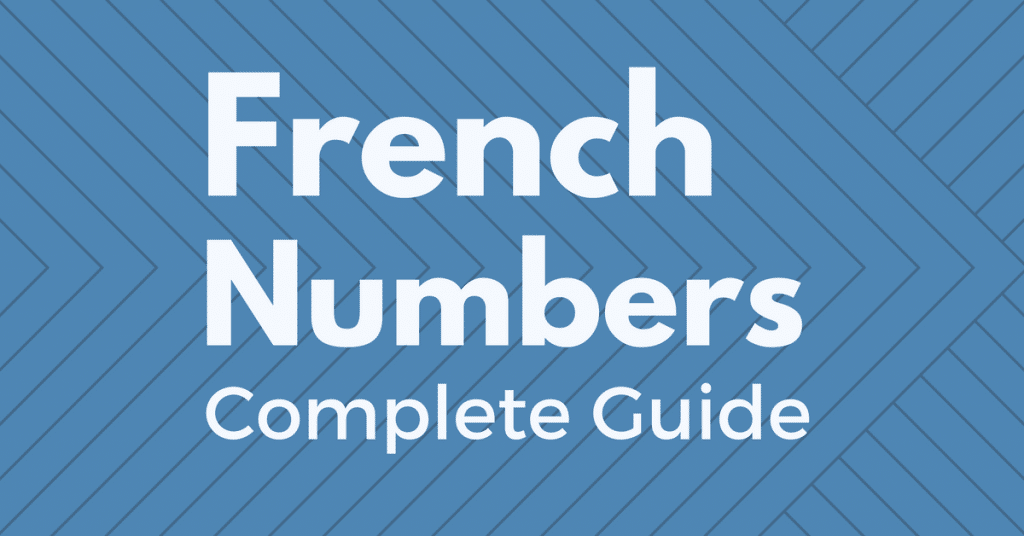Reading time: 6 minutes
Difficulty: Beginner
Before you start to shudder at the thought of learning about numbers in French, don't worry. There are no maths in here. We'll only be talking about the most important and practical topics about numbers – the kind of things that you actually need to know, and the ones that are useful in the real world. Plus, we'll be doing it the easiest way possible– ironing out the quirks as much as we can.
Fair enough?
But first, let us look at ordinal numbers and cardinal numbers and how they differ from each other.
- Cardinal numbers are used to tell us how many are there, or the quantity. Example, 1, 2, 3, 4 and so on.
- Ordinal numbers tell us the position or the order in relation to other numbers. Example, 1st, 2nd, 3rd, 4th and so on.
Twenty people joined the party. (cardinal number is used)
The twentieth person joined the party. (ordinal number is used)
See the difference?

Part 1: Cardinal Numbers
Now let's take a look at the French cardinal numbers. A pronunciation guide is added in the last column to help you practice saying the numbers.
| 1 | un | ung |
| 2 | deux | deu |
| 3 | trois | trwa |
| 4 | quatre | katr |
| 5 | cinq | sank |
| 6 | six | sees or see |
| 7 | sept | set |
| 8 | huit | wheat |
| 9 | neuf | neuf |
| 10 | dix | deece or dee |
| 11 | onze | ohnz |
| 12 | douze | dooz |
| 13 | treize | trayz |
| 14 | quatorze | kat-ORZ |
| 15 | quinze | cans |
| 16 | seize | sayz |
| 17 | dix-sept | dee-SET |
| 18 | dix-huit | dee-ZWEET |
| 19 | dix-neuf | dee-ZNEUF |
| 20 | vingt | vang |
| 21 | vingt-et-un | vang-tay-UNG |
| 22 | vingt-deux | vang-DEU |
| 23 | vingt-trois | vang-TRWA |
| 30 | trente | trongt |
| 40 | quarante | kar-AHNGT |
| 50 | cinquante | sank-AHNGT |
| 60 | soixante | swah-SAHNGT |
| 70 | soixante-dix | swah-sahngt-DEE |
| 80 | quatre-vingt | katr-VANG |
| 90 | quatre-vingt-dix | katr-vang-DEE |
| 100 | cent | sahng |
| 200 | deux cent | deu sahng |
| 300 | trois cent | trwa sahng |
| 1000 | mille | meel |
| 2000 | deux mille | deu meel |
| 1,000,000 | un million | ung mee-LYOHNG |
If you were quick enough to notice the difference, you're probably wondering why everything got all messed up starting from seventy.
What we're saying is this:
- sixty is soixante
- seventy is soixante-dix (literally sixty-ten)
- seventy-two is soixante-douze (literally sixty-twelve)
- seventy-nine is soixante-dix-neuf (literally sixty-ten-nine)
Confusing? We know, right?! But on the bright side, it means you don't have to learn new numbers, you only have to make use of the ones you already know!
When it comes to the eighties and nineties, it gets even more confusing! (and you thought English numbers were difficult?!)
Here, take a look:
- eighty is quatre-vingts (literally four-twenties)
- eighty-two is quatre-vingt-deux (literally four-twenty-two)
So there's a tiny bit of math here (just a tad little bit). To understand the logic behind it, you have to get a bit of grasp about basic addition and multiplication at the very least. It is just like President Abraham Lincoln's Gettysburg address: the famous line “four score and seven years ago”.
A score means twenty years, so four score and seven ((4 x 20) + 7) is eighty-seven.
That's basically in the same vein as the French numbers we're trying to learn.
For the nineties:
- ninety is quatre-vingt-dix (literally four-twenty-ten)
- ninety-two is quatre-vingt-douze (literally four-twenty-twelve)
If you could just grasp the underlying logic, the process would be so much easier to learn.
Quick tip: In other French-speaking countries like Belgium and Switzerland, they have different words for seventy, eighty and ninety.
Seventy is septante in both Belgium and Switzerland
Eighty is huitante in Switzerland (but not in Belgium)
Ninety is nonante in both Belgium and SwitzerlandBut if you find this all too confusing that your brain cells can't seem to take more number rules, just stick to the regular French numbers soixante-dix, quatre-vingts, quatre-vingt-dix and so on. You'll still be understood no matter which French-speaking country you go to anyway.
ADDITIONAL RULES IN FRENCH CARDINAL NUMBERS
1. When to use et and hyphens with cardinal numbers?
The rule goes like this.
You use et for the following numbers:
21 vingt et un
31 trente et un
41 quarante et un
51 cinquante et un
61 soixante et un
71 soixante et onze
You use hyphens for the following numbers:
17, 18, 19, 22 – 29, 32 – 39 up to 79, and then 80 – 99
2. When to use figures when writing cardinal numbers?
In most instances, cardinal numbers are being spelled out. Except for the following:
- In dates
Example: le 29 janvier 1950
- In prices
Example: L'armoire coûte 449 euros (the cupboard costs 449 euros)
- In weights and measures
Example: Vous pesez 56 kilos pour 1,70 mètre (you weigh 56 kilos for 1 meter 70)
- In mathematical usage
- In percentages
- In addresses and telephone numbers
3. How to say approximate numbers in French?
In English, we often use the expression “around” or “about” to make a quick guess about the numbers. For example: (1) There were around twenty students who joined the class. (2) about a thousand people watched the concert.
In French, you simply add -aine to the number. Like this:
une dizaine (about ten)
une quinzaine (about fifteen)
une vingtaine (about twenty)
une centaine (about one hundred)
It's kinda like (but not quite) the use of -ish in urban lingo.
Example:
Q: How many people went to the party?
A: Like, 50-ish or so.
Here are some very useful videos for you to check out:
PART 2: ORDINAL NUMBERS
Once you have familiarized yourself with the cardinal numbers, learning ordinal numbers is a lot easier. Ordinal numbers except for 'one' are derived from its corresponding number.
The general rule for ordinal numbers is: use the cardinal number, drop the last letter e (if any), and add the suffix -ième.
Using this formula, let's try some examples:
- quatre --- drop the last -e, becomes qatr --- add -ième, becomes qatrième
- six --- since there is no -e in the ending, we add -ième, so it becomes sixième
Important items to note:
- First or premier (m) and première (f) is the only cardinal number that doesn't follow the rule above.
- Cinquième and neuvième follow the rule except for a few spelling changes in the original word. Twenty-first, thirty-first, forty-first, and so on, also follow the rule.
- Unlike in English, French does not use ordinal numbers when talking about dates.
- Most fractions are also derived from the ordinal numbers. Here are examples:
- 1/5 is un cinquième
- 1/6 is un sixième
- 1/7 is un septième
- 1/8 is un huitième
- 1/9 is un neuvième
- 1/10 is un dixième
- 2/5 is deux cinquièmes
For additional material in learning ordinal numbers, check out this video as well:
Please tell us in the comment section if there are some vocabulary topics that you would like to review.
P.S. You would be doing me a HUGE FAVOR by sharing it via Twitter or Facebook.

Speak, Listen, and Write French like a Native with Talk in French Complete Courses


[…] If you are already familiar with French numbers, this part should be a breeze to you. If not, you may want to brush up on your numbers by heading over to the article The Easy Guide to French Numbers. […]
This is great. I am on my final week of a beginners level French class. Very useful.
Thank you! Please let us know what you would like to learn next.
Hi Frederic,
Great article. Congratulations.
You wrote: “ninety-two is quatre-vingt-DEUX (literally four-twenty-twelve) ”
I think the correct form would be: “ninety-two is quatre-vingt-DOUZE (literally four-twenty-twelve)”
Yes, correct. I just fixed it. Thank you to let me know.
Thanks! very useful. I’m an absolute beginner and I have pronunciation problems. What’s you advice?
For proununciation, I would suggest to check first our article about french pronunciation. https://www.talkinfrench.com/french-pronunciation-guide/ .
Where is the zero?
It is not here. We never teach with zero as you can see in the youtube video.